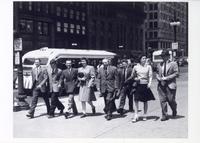(9,421 - 9,440 of 10,078)
Pages
-

-
Title
-
Harold Leonard Stuart Building, Illinois Institute of Technology, Chicago, Illinois, ca. 1970s
-
Date
-
1970-1979
-
Description
-
Photograph of Harold Leonard Stuart Building, located at 10 West 31st Street. The building was designed by Myron Goldsmith, Skidmore, Owings &...
Show morePhotograph of Harold Leonard Stuart Building, located at 10 West 31st Street. The building was designed by Myron Goldsmith, Skidmore, Owings & Merrill and constructed in 1969-71. Photographer unknown. Date of photograph is unknown. Date range listed is approximate.
Show less
-
Collection
-
Office of Communications and Marketing photographs, 1905-1999
-

-
Title
-
Lewis Hall, with Farr Hall, fraternity houses and IIT Tower in the background, Illinois Institute of Technology, ca. late 1960s
-
Date
-
1966-1969
-
Description
-
Photograph of Lewis Hall, designed by Mittelbusher & Tourtelot and constructed in 1966. The building is located at 70 East 33rd Street....
Show morePhotograph of Lewis Hall, designed by Mittelbusher & Tourtelot and constructed in 1966. The building is located at 70 East 33rd Street. Formerly known as: Women's Hall (ca. 1970s). IIT Tower, Farr Hall, a fraternity house (likely Pi Kappa Phi), and other buildings are visible in the background. Photographer unknown. Date of photograph is unknown. Date range listed is approximate.
Show less
-
Collection
-
Office of Communications and Marketing photographs, 1905-1999
-

-
Title
-
Illinois Institute of Technology Architcture faculty and students walking in the Loop, Chicago, Illinois, ca. 1940-1941
-
Date
-
1940-1941
-
Description
-
Photograph of faculty and student members of the Illinois Institute of Technology architecture program circa 1940-1941, taken by George W....
Show morePhotograph of faculty and student members of the Illinois Institute of Technology architecture program circa 1940-1941, taken by George W. Larson, a 1942 graduate. From left to right: Leon Przybylski, (perhaps) William Hasskarl, Mary Elizabeth Spies Droste, Ludwig Hilberseimer, George Storz, Elizabeth Wright (Ingram), and Alfred Caldwell.
Show less
-
Collection
-
George W. Larson photographs, 1940-1941
-

-
Title
-
Illinois Institute of Technology Department of Architecture faculty, 1948
-
Date
-
1948
-
Description
-
Photograph of the 1948 Illinois Institute of Technology Department of Architecture faculty. Left to right: George Danforth, Ludwig...
Show morePhotograph of the 1948 Illinois Institute of Technology Department of Architecture faculty. Left to right: George Danforth, Ludwig Hilberseimer, Thomas Burleigh, Alfred Caldwell, Ludwig Mies van der Rohe, Edward Duckett, Daniel Brenner, Earl Bluestein, A. James Speyer. Photographer unknown.
Show less
-
Collection
-
Office of Communications and Marketing photographs, 1905-1999
-

-
Title
-
Illinois Institute of Technology campus plan, 1940
-
Date
-
1940
-
Description
-
Reproduction of Alfred Alschuler's 1940 campus plan for Illinois Institute of Technology. While he helped design at least one building on the...
Show moreReproduction of Alfred Alschuler's 1940 campus plan for Illinois Institute of Technology. While he helped design at least one building on the Illinois Tech campus, Alschuler's campus plan would never be realized. instead, Ludwig Mies van der Rohe's plan was chosen and built beginning in 1943.
Show less
-
Collection
-
John P. Makielski papers, 1940-1950
-

-
Title
-
1900s
-
Date
-
1969-1978
-
Description
-
Photograph taken by photographer Howard LeVant/LeVant Photography for the Klau-Van Pietersom-Dunlap (KVPD) agency and Kimberly-Clark. Date of...
Show morePhotograph taken by photographer Howard LeVant/LeVant Photography for the Klau-Van Pietersom-Dunlap (KVPD) agency and Kimberly-Clark. Date of photograph is unknown. Date range listed (1969-1978) is approximate. Title supplied by Howard LeVant.
Show less
-
Collection
-
Howard LeVant papers, 1950-2020
-

-
Title
-
Mid 1800s
-
Date
-
1969-1978
-
Description
-
Photograph taken by photographer Howard LeVant/LeVant Photography for the Klau-Van Pietersom-Dunlap (KVPD) agency and Kimberly-Clark. Date of...
Show morePhotograph taken by photographer Howard LeVant/LeVant Photography for the Klau-Van Pietersom-Dunlap (KVPD) agency and Kimberly-Clark. Date of photograph is unknown. Date range listed (1969-1978) is approximate. Title supplied by Howard LeVant.
Show less
-
Collection
-
Howard LeVant papers, 1950-2020
-

-
Title
-
Bob Hope
-
Date
-
1990-1999
-
Description
-
Photograph taken by photographer Howard LeVant for the Rochester Institute of Technology. Date of photograph is unknown. Date range listed ...
Show morePhotograph taken by photographer Howard LeVant for the Rochester Institute of Technology. Date of photograph is unknown. Date range listed (1990-1999) is approximate. Title supplied by Howard LeVant, labeled as "RIT Promo."
Show less
-
Collection
-
Howard LeVant papers, 1950-2020
Pages